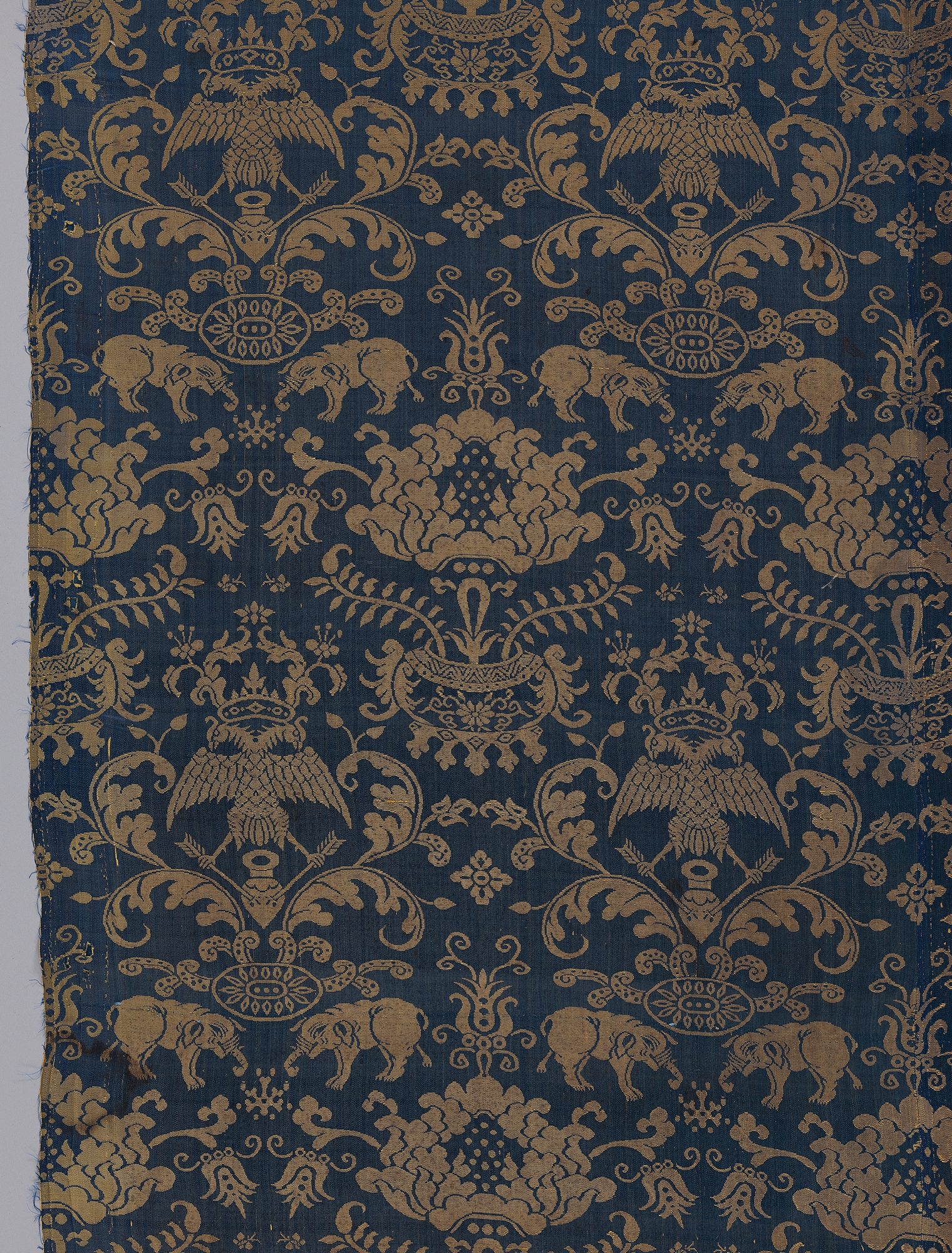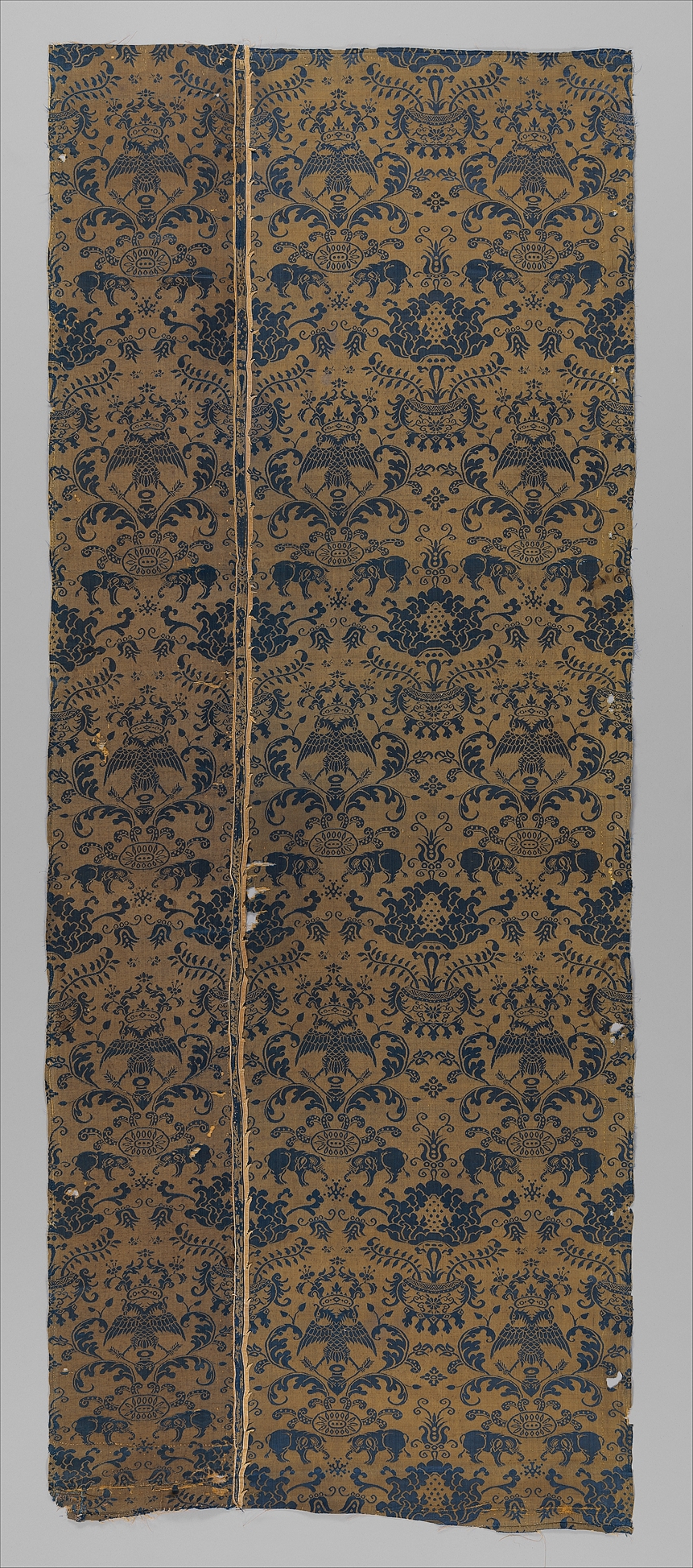Textile with elephants, crowned double headed eagles, and flowers
Chinese, Macao, for Iberian market
Not on view
A symbol of exoticism and power, the Asian elephant (identified by its small ears) shares the visual space of this finely patterned silk satin damask with a European double-headed crowned eagle beneath a stylized, oval-shaped lotus.¹ The elephant is shown with multiple tusks, three on one side and one peeking out on the other. As such, the animal seen here likely represents the Buddhist six-tusked elephant described in a fifth-century Chinese translation of a sutra as being resplendent and white and having lotuses, jade maidens, and other symbolic figures at the end of each tusk.²
Elephants have a long history in China. Given as tribute to the emperor by local rulers, particularly from neighboring Southeast Asian regions where they were raised, elephants were also presented as diplomatic gifts to important foreign kings. Apart from their use as work animals and army transport, they were sometimes tamed to provide entertainment in times of leisure, beloved by the royal courts. In sixteenth-century Europe, elephants held a similar fascination for royals and commoners alike, and they appear in the works of such artists as Durer and Raphael. Shipped by boat from Ceylon to Lisbon, elephants were offered as gifts of the Portuguese kings to the courts of Spain, Austria, France, and England. In 1514, Manuel I of Portugal gave a white elephant (the famous "Hanno" known through Raphael's drawings) to Pope Leo X. An elephant given by the court of Lisbon to Philip II of Spain in 1581 was subsequently passed along to Henry IV of France. A year later Henry, in turn, gve it to Queen Elizabeth of England, a brillia;nt "re-gifting" of an asset deemed too expensive to maintain.³
Here the combination of Buddhist symbols and Habsburg eagles produces a composite message of a religious and political nature that juxtaposes the two cultures of Asia and Europe. We do not know how long this long-preserved length of fabric was originally used, but its delicate quality indicates that it may have been part of a garment or hanging.⁴
Woven in China and likely exported through the port of Macau, this textile's blend of Asian and European taste and style was intended for a foreign market that may not have understood the Buddhist elements but nonetheless would have appreciated the fine weaving and exotic designs.
[Melinda Watt, adapted from Interwoven Globe, The Worldwide Textile Trade, 1500-1800/ edited by Amelia Peck; New York: Metropolitan Museum of Art; New Haven: distributed by Yale University Press, 2013]
Footnotes
1. The textile is composed of a five-harness satin damask, with a blue warp and yellow weft. The blue color is presumably indigo, while the yellow dye was made from the Asian pagoda tree (Sophora japonica). Dye analysis was conducted by Nobuko Shibayama in the Department of Scientific Research, Metropolitan Museum, with High Performance Liquid Chromatography-Photo Diode Array (HPLC-PDA).
2. "The creature is colossal . . . and is whiter than the snows of the Himalayas. At the ends of his six tusks are six bathing tanks, in each of which grow fourteen lotuses. On each open blossom is a ‘jade maiden’ fairer than the damsels of Paradise, in whose hands are five spontaneously created lutes; each lute is accompanied by 500 other musical instruments, and 500 jewel-colored birds." Guan Puxian pu sa xing fa jing (Sutra on the Practice of Visualizing the Bodhisattva Samantabhadra), in Soper, "Literary Evidence for Early Buddhist Art in China," p. 223.
3. See Bedini, The Pope’s Elephant, Gschwend and Bellet, The Story of Suleyman, and Lach, "The Elephant," pp. 152 ? 58.
4. The panel comprises two widths of cloth seamed together: identical patterns that are somewhat mismatched at the join. A fragment of the white selvage with a blue stripe is preserved along the seam in two areas (visible at the back). Digby, "Some Silks Woven under Portuguese Influence in the Far East," pp. 55 ? 56 and n. 11, notes that several Asian damasks from Macau have a white twill selvage with a stripe and that the structure of this selvage is distinct from other silks thought to be from Macau; the elephant silk conforms to the technical features of that group. Since we have little information as to the exact provenance of these textiles, technical features such as these can be important for identifying the potential locale of their production
Due to rights restrictions, this image cannot be enlarged, viewed at full screen, or downloaded.
This artwork is meant to be viewed from right to left. Scroll left to view more.




